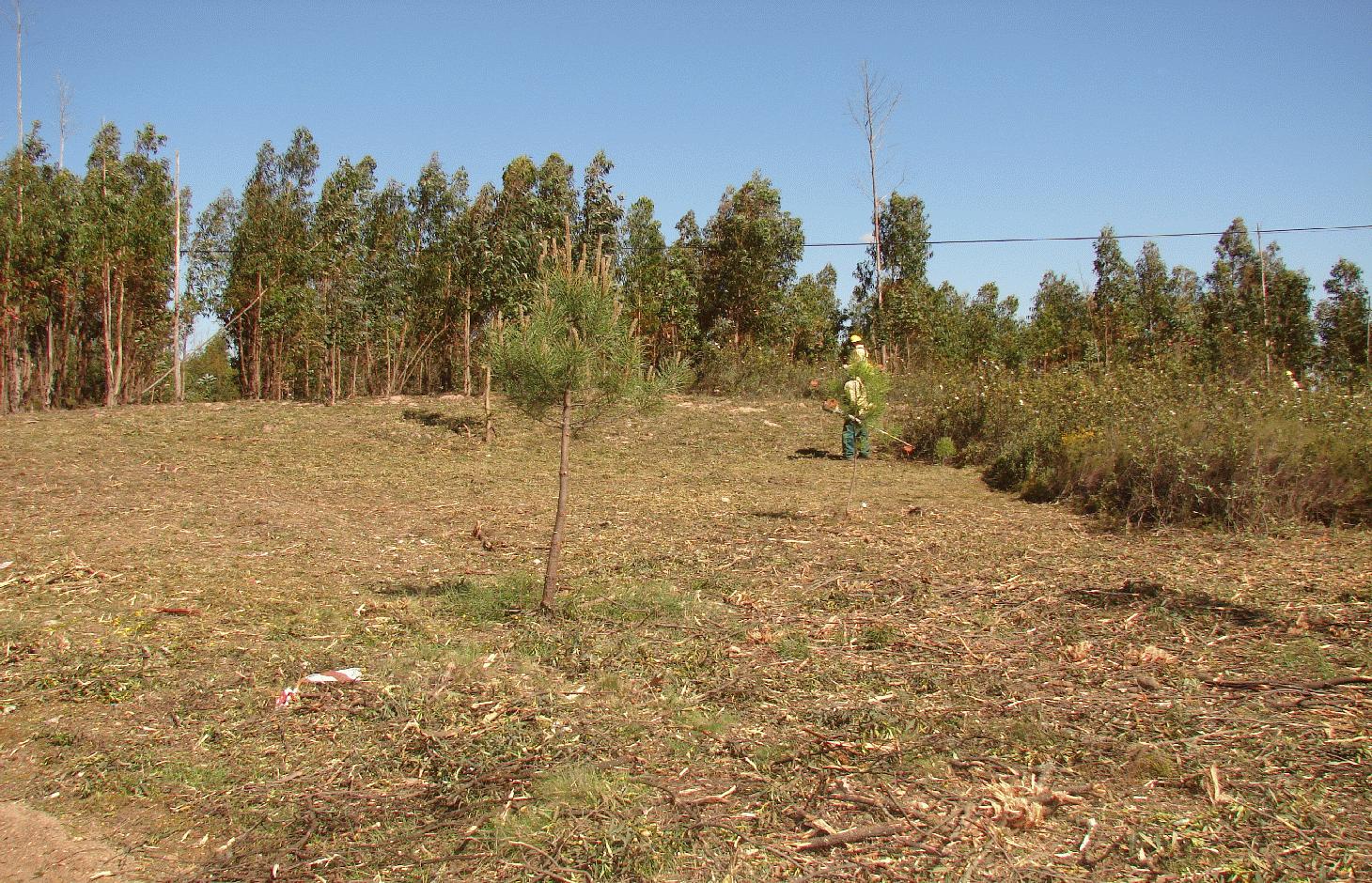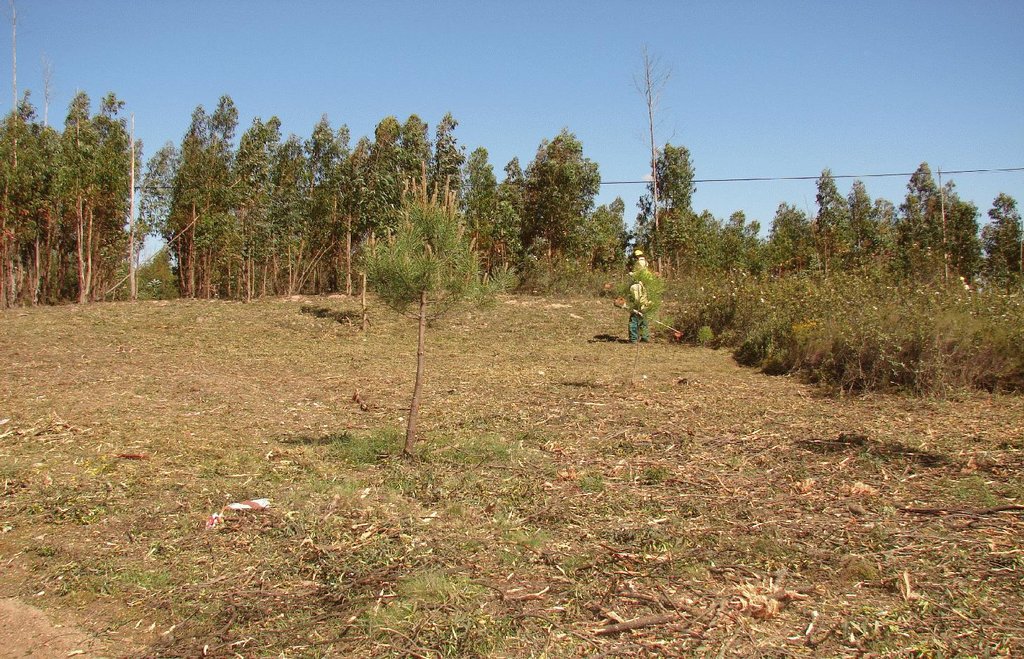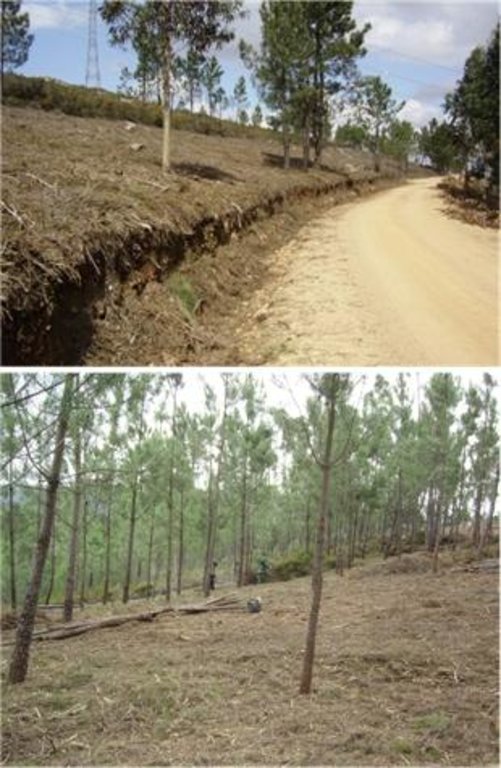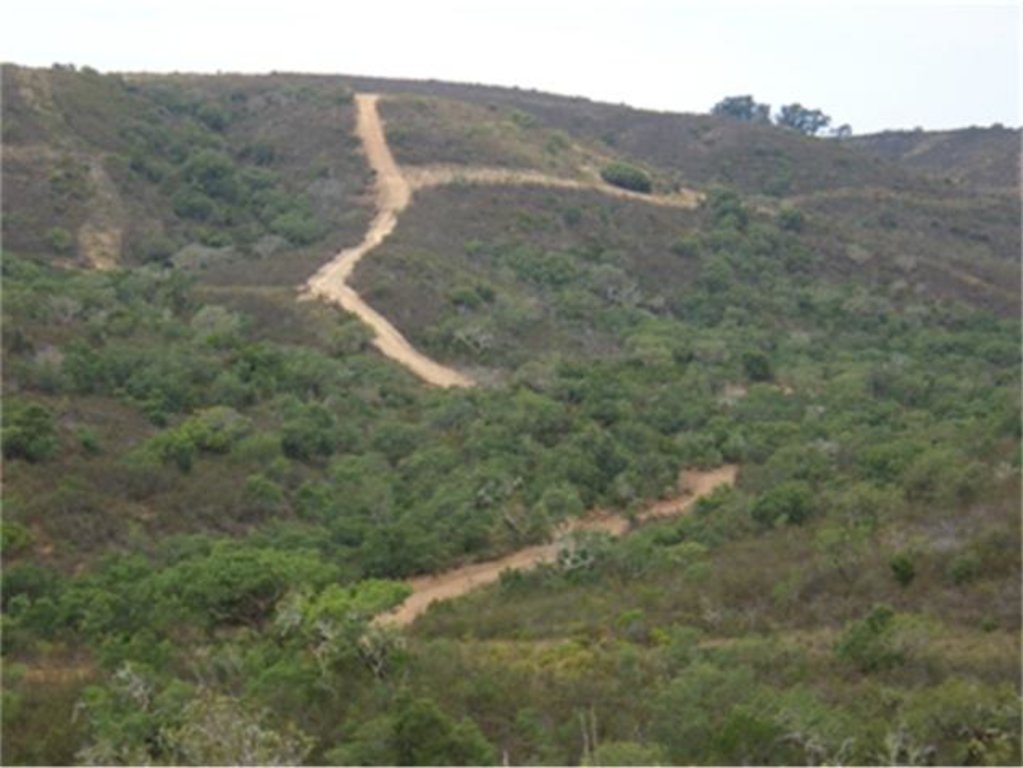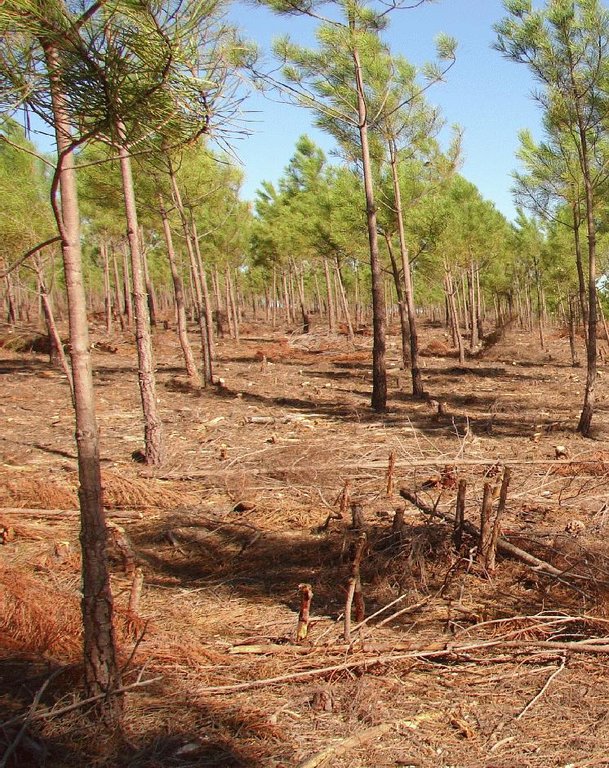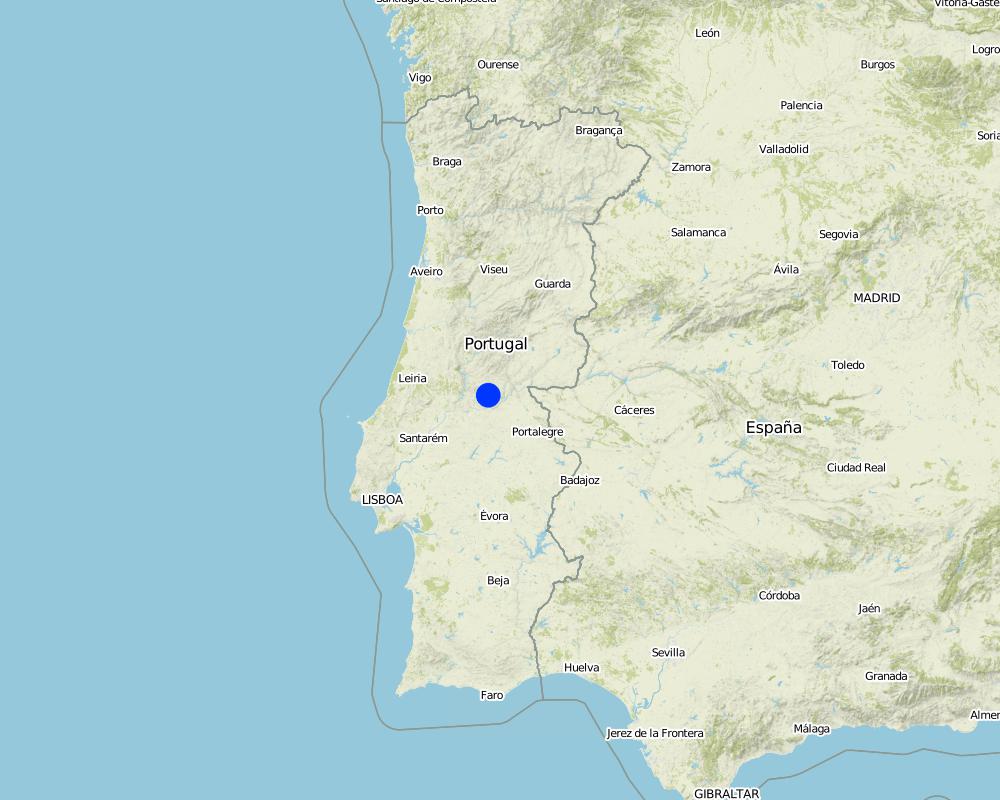Primary strip network system for fuel management [ប្រទេសព័រទុយហ្គាល់]
- ការបង្កើត៖
- បច្ចុប្បន្នភាព
- អ្នកចងក្រង៖ Celeste Coelho
- អ្នកកែសម្រួល៖ –
- អ្នកត្រួតពិនិត្យច្រើនទៀត៖ Deborah Niggli, Alexandra Gavilano
Primary strip network system for fuel management
technologies_1361 - ប្រទេសព័រទុយហ្គាល់
ពិនិត្យមើលគ្រប់ផ្នែក
ពង្រីកមើលទាំងអស់ បង្រួមទាំងអស់1. ព័ត៌មានទូទៅ
1.2 ព័ត៌មានលម្អិតពីបុគ្គលសំខាន់ៗ និងស្ថាប័នដែលចូលរួមក្នុងការវាយតម្លៃ និងចងក្រងឯកសារនៃបច្ចេកទេស
អ្នកជំនាញឯកទេស SLM:
អ្នកជំនាញឯកទេស SLM:
Louro António
Aflomação - Forest Association of Mação
ប្រទេសព័រទុយហ្គាល់
អ្នកជំនាញឯកទេស SLM:
Ventinhas Marta
Aflomação - Forest Association of Mação
ប្រទេសព័រទុយហ្គាល់
អ្នកជំនាញឯកទេស SLM:
Bragança Nuno
Aflomação - Forest Association of Mação
អ្នកជំនាញឯកទេស SLM:
Mariano Inês
Aflomação - Forest Association of Mação
ប្រទេសព័រទុយហ្គាល់
ឈ្មោះគម្រោងដែលបានចងក្រងឯកសារ/ វាយតម្លៃលើបច្ចេកទេស (បើទាក់ទង)
DESIRE (EU-DES!RE)ឈ្មោះអង្គភាពមួយ (ច្រើន) ដែលបានចងក្រងឯកសារ/ វាយតម្លៃបច្ចេកទេស (បើទាក់ទង)
University of Aveiro (University of Aveiro) - ប្រទេសព័រទុយហ្គាល់ឈ្មោះអង្គភាពមួយ (ច្រើន) ដែលបានចងក្រងឯកសារ/ វាយតម្លៃបច្ចេកទេស (បើទាក់ទង)
Forest Association of Mação (Aflomação) (Aflomação) - ប្រទេសព័រទុយហ្គាល់1.3 លក្ខខណ្ឌទាក់ទងទៅនឹងការប្រើប្រាស់ទិន្នន័យដែលបានចងក្រងតាមរយៈ វ៉ូខេត
អ្នកចងក្រង និង(បុគ្គលសំខាន់ៗ)យល់ព្រមទទួលយកនូវលក្ខខណ្ឌនានាទាក់ទងទៅនឹងការប្រើប្រាស់ទិន្នន័យដែលបានចងក្រងតាមរយៈវ៉ូខេត:
បាទ/ចា៎
1.5 ការយោងទៅលើកម្រងបញ្ជីសំណួរ (មួយ ឬច្រើន) នៃវិធីសាស្ត្រផ្សព្វផ្សាយ SLM (ដែលបានចងក្រងដោយទស្សនៈពិភពលោកស្តីពីវិធីសាស្ត្រ និងបច្ចេកទេសងអភិរក្ស WOCAT)
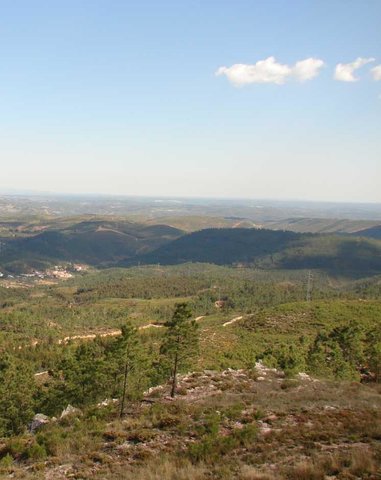
Forest Intervention Area (ZIF) [ប្រទេសព័រទុយហ្គាល់]
Forest Intervention Area (ZIF) is a territorial unit, where the main land use is forestry. This approach assembles and organizes small forest holders and defines a joint intervention for forest management and protection. Defined by law in 2005, and revised in 2009, each ZIF of private forest has to include …
- អ្នកចងក្រង៖ Celeste Coelho
2. ការពណ៌នាពីបច្ចេកទេស SLM
2.1 ការពណ៌នាដោយសង្ខេបពីបច្ចេកទេស
និយមន័យបច្ចេកទេស:
Linear strips are strategically located in areas where total or partial removal of the forest biomass is possible. This technology contributes towards preventing the occurrence and spread of large forest fires and reducing their consequences for the environment, people, infrastructures, etc.
2.2 ការពណ៌នាលម្អិតពីបច្ចេកទេស
ការពណ៌នា:
There are three types of strip for fuel management in forest areas: primary, secondary and tertiary, defined by the Law 17/2009. The most important differences between them are in terms of size (primary being the widest and the tertiary the narrowest) and scale (primary referring to the district level, secondary to the municipal level and tertiary to the parish level). The primary strip network system for fuel management (RPFGC) is integrated in the National System to Prevent and Protect Forest against Fires and it is defined by the National Forest Authority (AFN).
Purpose of the Technology: The RPFGC aims to re-arrange landscape elements, through the establishment of discontinuities in the vegetation cover, in forest areas and in the rural landscape (for example using water bodies, agricultural land, pasture, rocky outcrops, shrubland and valuable forest stands). Land tenure is private in most of the areas covered by the RPFGC. The main objectives of this technology are: to decrease the area affected by large fires; to enable direct access by fire fighters; to reduce fire effects and protect roads, infrastructures and social equipment, urban areas and forest areas of special value; and to isolate potential fire ignition sources.
Establishment / maintenance activities and inputs: These primary strips are ≥ 125 metres wide and preferably between 500 and 10,000 ha in area. The tree cover should be less than 50% of the area and the base of the tree canopy should not be lower than 3 metres. The RPFGC concept should include the adoption of a maintenance programme. The implementation and maintenance operations can be performed through different agro-forest technologies, such as clearance of bushes and trees, pruning, prescribed fire, harrowing and cultivation of the ground beneath the trees. Timber products can be sold and the removed litter can be used in a biomass power plant or applied to the fields to improve soil fertility, using mulching technology.
Natural / human environment: This SWC Technology needs considerable financial resources in terms of labour and equipment at the implementation phase. Costs, however, undergo considerable reduction thereafter. The implementation of this infrastructure to prevent and protect the land from forest fire is entirely funded by the government and implemented by the forest municipal services.
2.3 រូបភាពនៃបច្ចេកទេស
2.5 ប្រទេស/តំបន់/ទីតាំងកន្លែង ដែលបច្ចេកទេសត្រូវបានអនុវត្ត និងបានគ្រប់ដណ្តប់ដោយការវាយតម្លៃនេះ
ប្រទេស:
ប្រទេសព័រទុយហ្គាល់
តំបន់/រដ្ឋ/ខេត្ត:
Portugal
បញ្ជាក់បន្ថែមពីលក្ខណៈនៃទីតាំង:
Santarém / Mação
បញ្ជាក់ពីការសាយភាយនៃបច្ចេកទេស:
- ត្រូវបានផ្សព្វផ្សាយត្រឹមតំបន់មួយ
ប្រសិនបើបច្ចេកទេសត្រូវបានសាយភាយពាសពេញតំបន់ណាមួយ បញ្ជាក់ទំហំផ្ទៃដីអនុវត្តន៍ (គិតជា គ.ម2):
400,0
មតិយោបល់:
Total area covered by the SLM Technology is 400 km2.
There has been some work carried out to develop the secondary system of linear strips for fuel management. These will provide the basis for the implementation of the primary system. The PROF | PIS - Plano Regional de Ordenamento Florestal do Pinhal Interior Sul (Regional Plan for Forestry Management and Planning of the Pinhal Interior Sul) has designated an area of 1752 ha with a total length of 141 km as the contribution to the primary system of fire prevention by the Mação municipality.
Map
×2.6 កាលបរិច្ឆេទនៃការអនុវត្ត
ប្រសិនបើមិនច្បាស់ឆ្នាំ សូមបញ្ជាក់កាលបរិច្ឆេទដែលប្រហាក់ប្រហែល:
- តិចជាង 10ឆ្នាំមុន (ថ្មី)
2.7 ការណែនាំពីបច្ចេកទេស
សូមបញ្ជាក់តើបច្ចេកទេសត្រូវបានណែនាំឱ្យអនុវត្តដោយរបៀបណា:
- តាមរយៈគម្រោង / អន្តរាគមន៍ពីខាងក្រៅ
3. ចំណាត់ថ្នាក់នៃបច្ចេកទេស SLM
3.2 ប្រភេទដីប្រើប្រាស់មួយប្រភេទ (ច្រើនប្រភេទ) ដែលបានអនុវត្តបច្ចេកទេស
ដីប្រើប្រាស់ចម្រុះនៅលើដីតែមួយ:
បាទ/ចា៎
បញ្ជាក់ពីប្រភេទដីច្រើនប្រភេទ (ដីដាំដំណាំ/ដីចិញ្ចឹមសត្វ/ដីព្រៃឈើ):
- ដីព្រៃឈើ និងដីចិញ្ចឹមសត្វ

ដីសម្រាប់ចិញ្ចឹមសត្វ
ប្រភេទសត្វ:
- សត្វពពែ
- សត្វចៀម

ដីព្រៃ/ដីដាំដើមឈើ
- ព្រៃ (ពាក់កណ្តាល) ធម្មជាតិ/ ដីព្រៃ
ព្រៃ (ពាក់កណ្តាល) ធម្មជាតិ / ដីព្រៃ៖ បញ្ជាក់ប្រភេទនៃការគ្រប់គ្រង:
- កាប់តែមួយចំនួន
- កាប់ទាំងអស់
ប្រភេទឈើ:
- Eucalyptus species
- Pinus species (pine)
ផលិតផល និងសេវាកម្ម:
- ឈើហ៊ុប
- អុស
មតិយោបល់:
Major land use problems (compiler’s opinion): Forest fires increase due to rural depopulation and to land management abandonment.
Other grazingland: silvo-pastoralism: Goats and sheep.
Selective felling of (semi-) natural forests: Pine.
Clear felling of (semi-)natural forests: Eucalyptus.
Other type of forest: clear felling of (semi-)natural forests: Eucalyptus.
Forest products and services: timber, fuelwood
Constraints of settlement / urban: Proximity of forest to urban areas.
Constraints of infrastructure network (roads, railways, pipe lines, power lines): Ignition sources.
Number of growing seasons per year: 2
Longest growing period in days: 1Longest growing period from month to month: 1 per year
Livestock density: 1-10 LU /km2
3.4 ការផ្គត់ផ្គង់ទឹក
មតិយោបល់:
Water supply: rainfed, rainfed
3.5 ក្រុម SLM ដែលបច្ចេកទេសស្ថិតនៅក្នុង
- ការគ្រប់គ្រងព្រៃធម្មជាតិ និងព្រៃពាក់កណ្តាលធម្មជាតិ
- កាត់បន្ថយហានិភ័យនៃបញ្ហាលើប្រព័ន្ធអេកូឡូស៊ី
3.6 វិធានការ SLM ដែលបញ្ចូលនូវបច្ចេកទេស

វិធានការរចនាស័ម្ពន្ធ
- S11: ផ្សេងៗ
មតិយោបល់:
Main measures: structural measures
3.7 កំណត់ប្រភេទនៃការធ្លាក់ចុះគុណភាពដីសំខាន់ៗដែលបច្ចេកទេសនេះបានដោះស្រាយ

ការធ្លាក់ចុះជីវសាស្ត្រនៃដី
- Bf: ផលប៉ះពាល់ដែលបណ្តាលមកពីភ្លើងឆេះ
មតិយោបល់:
Main type of degradation addressed: Bf: detrimental effects of fires
Main causes of degradation: deforestation / removal of natural vegetation (incl. forest fires) (Forest fire frequency and intensity.), Property size (Small pieces of land (< 0.5 ha).)
Secondary causes of degradation: Population density (Ageing population structure and depopulation.)
3.8 ការពារ កាត់បន្ថយ ឬស្តារឡើងវិញនៃការធ្លាក់ចុះគុណភាពដី
បញ្ជាក់ពីគោលដៅរបស់បច្ចេកទេស ដែលផ្តោតទៅការធ្លាក់ចុះគុណភាពដី:
- ការការពារការធ្លាក់ចុះគុណភាពដី
មតិយោបល់:
Main goals: prevention of land degradation
4. បច្ចេកទេសជាក់លាក់ សកម្មភាពអនុវត្ត ធាតុចូល និងថ្លៃដើម
4.1 គំនូសបច្ចេកទេសនៃបច្ចេកទេសនេះ
លក្ខណៈពិសេសនៃបច្ចេកទេស (ទាក់ទងនឺងគំនូរបច្ចេកទេស):
This technical drawing indicates the technical specifications, dimensions and spacing for the Primary Strip Network System for Fuel Management. The figure shows a road as the axis of the RPFGC, but it can also be a river or a ridge, amongst other breaks in the forest cover.
Location: Portugal. Santarém / Mação
Date: 16/01/2009
Technical knowledge required for field staff / advisors: high
Technical knowledge required for land users: low
Main technical functions: control of fires
Secondary technical functions: reduction of dry material (fuel for wildfires), spatial arrangement and diversification of land use
ឈ្មោះអ្នកនិពន្ធ:
João Soares, University of Aveiro, Campus Universitário de Santiago, 3810 - 193 Aveiro, Portugal
4.2 ព័ត៌មានទូទៅដែលពាក់ព័ន្ធនឹងការគណនាធាតុចូល និងថ្លៃដើម
ផ្សេងៗ/ រូបិយប័ណ្ណជាតិ (បញ្ជាក់):
Euro
បើពាក់ព័ន្ធសូមកំណត់អត្រាប្តូរប្រាក់ពីដុល្លាទៅរូបិយប័ណ្ណតំបន់ (ឧ. 1 ដុល្លារ = 79.9 រៀលនៃរូបិយប័ណ្ណប្រេស៊ីល) ៖ 1 ដុល្លារ =:
0,76
កំណត់ថ្លៃឈ្នួលជាមធ្យមនៃការជួលកម្លាំងពលកម្មក្នុងមួយថ្ងៃ:
18.75
4.3 សកម្មភាពបង្កើត
| សកម្មភាព | រយៈពេល (រដូវកាល) | |
|---|---|---|
| 1. | Primary System design | n. a. |
| 2. | Shrubs cleaning + Thinning (reduction of fuel load) + Pruning | Dry season |
| 3. | Removing the cut waste material | |
| 4. | Litter Shredding | |
| 5. | Transport to the Biomass Plant |
4.4 ថ្លៃដើម និងធាតុចូលដែលត្រូវការសម្រាប់ការបង្កើតបច្ចេកទេស
| បញ្ជាក់ពីធាតុចូល | ឯកតា | បរិមាណ | ថ្លៃដើមក្នុងមួយឯកតា | ថ្លៃធាតុចូលសរុប | % នៃថ្លៃដើមដែលចំណាយដោយអ្នកប្រើប្រាស់ដី | |
|---|---|---|---|---|---|---|
| កម្លាំងពលកម្ម | Labour | ha | 1,0 | 1076,0 | 1076,0 | |
| សម្ភារៈ | Machine use | ha | 1,0 | 568,0 | 568,0 | |
| សម្ភារៈ | Transport | ha | 1,0 | 100,0 | 100,0 | |
| ថ្លៃដើមសរុបក្នុងការបង្កើតបច្ចេកទេស | 1744,0 | |||||
| ថ្លៃដើមសរុបក្នុងការបង្កើតបច្ចេកទេសគិតជាដុល្លារ | 2294,74 | |||||
4.6 កំណត់ថ្លៃដើមសម្រាប់ការថែទាំ/ សកម្មភាពរបស់បច្ចេកទេស (ក្នុងរយៈពេលមួយឆ្នាំ)
មតិយោបល់:
The costs calculation was made for the implementation of the first section of the RPFGC. The implementation phase lasted for 2 or 3 months during the dry season. This section included 28 ha and 4 teams of forest sappers were involved.
4.7 កត្តាសំខាន់បំផុតដែលមានឥទ្ធិពលដល់ការចំណាយ
ពណ៌នាពីកត្តាប៉ះពាល់ចម្បងៗទៅលើថ្លៃដើម:
The costs include the activities to ensure the vertical and horizontal discontinuity of the fuel load and also the activities needed to manage the waste produced from the shrubs cleaning and thinning.
5. លក្ខណៈបរិស្ថានធម្មជាតិ និងមនុស្ស
5.1 អាកាសធាតុ
បរិមាណទឹកភ្លៀងប្រចាំឆ្នាំ
- < 250 មម
- 251-500 មម
- 501-750 មម
- 751-1,000 មម
- 1,001-1,500 មម
- 1,501-2,000 មម
- 2,001-3,000 មម
- 3,001-4,000 មម
- > 4,000 មម
លក្ខណៈពិសេស/ មតិយោបល់លើរដូវភ្លៀង:
The rainfall ranges from 1000 mm in the North to less than 600 mm per year in the South of the municipality.
តំបន់កសិអាកាសធាតុ
- មានភ្លៀងមធ្យម
Thermal climate class: temperate
5.2 សណ្ឋានដី
ជម្រាលជាមធ្យម:
- រាបស្មើ (0-2%)
- ជម្រាលតិចតួច (3-5%)
- មធ្យម (6-10%)
- ជម្រាលខ្ពស់បន្តិច (11-15%)
- ទីទួល (16-30%)
- ទីទួលចោត (31-60%)
- ទីទួលចោតខ្លាំង (>60%)
ទម្រង់ដី:
- ខ្ពង់រាប
- កំពូលភ្នំ
- ជម្រាលភ្នំ
- ជម្រាលទួល
- ជម្រាលជើងភ្នំ
- បាតជ្រលងភ្នំ
តំបន់តាមរយៈកម្ពស់ :
- 0-100 ម
- 101-500 ម
- 501-1,000 ម
- 1,001-1,500 ម
- 1,501-2,000 ម
- 2,001-2,500 ម
- 2,501-3,000 ម
- 3,001-4,000 ម
- > 4,000 ម
បញ្ជាក់ថាតើបច្ចេកទេសនេះត្រូវបានអនុវត្តន៍នៅក្នុង:
- សណ្ឋានដីផត
5.3 ដី
ជម្រៅដីជាមធ្យម:
- រាក់ខ្លាំង (0-20 សម)
- រាក់ (21-50 សម)
- មធ្យម (51-80 សម)
- ជ្រៅ (81-120 សម)
- ជ្រៅខ្លាំង (> 120 សម)
វាយនភាពដី (ស្រទាប់លើ):
- មធ្យម (ល្បាយ, ល្បាប់)
សារធាតុសរីរាង្គនៅស្រទាប់ដីខាងលើ:
- ទាប (<1%)
បើអាចសូមភ្ជាប់ការពណ៌នាពីដីឱ្យបានច្បាស់ ឬព័ត៌មានដែលអាចទទួលបាន ឧ. ប្រភេទដី, pH ដី/ ជាតិអាស៊ីត, សមត្ថភាពផ្លាស់ប្តូរកាចុង, វត្តមាននីត្រូសែន, ភាពប្រៃ ។ល។:
Soil depth on average is very shallow: Thin and stony terrains
Soil fertility is low
Soil drainage/infiltration is poor
Soil water storage capacity is low
5.4 ទឹកដែលអាចទាញមកប្រើប្រាស់បាន និងគុណភាពទឹក
នីវ៉ូទឹកក្រោមដី:
5-50 ម
ទឹកលើដីដែលអាចទាញយកប្រើប្រាស់បាន:
កម្រិតមធ្យម
គុណភាពទឹក (មិនបានធ្វើប្រត្តិកម្ម):
ទឹកពិសារដែលមានគុណភាពល្អ
5.5 ជីវៈចម្រុះ
ភាពសម្បូរបែបនៃប្រភេទ:
- កម្រិតមធ្យម
5.6 លក្ខណៈនៃអ្នកប្រើប្រាស់ដីដែលអនុវត្តបច្ចេកទេស
ទីផ្សារនៃប្រព័ន្ធផលិតកម្ម:
- ពាក់កណ្តាលពាណិជ្ជកម្ម (ផ្គត់ផ្គង់ខ្លួនឯង/ ពាណិជ្ជកម្ម)
ចំណូលក្រៅកសិកម្ម:
- ច្រើនជាង 50% នៃចំណូល
កម្រិតជីវភាព:
- មិនល្អ
- មធ្យម
ឯកជន ឬក្រុម:
- ជាក្រុម/ សហគមន៍
កម្រិតប្រើប្រាស់គ្រឿងយន្ត:
- ប្រើកម្លាំងពលកម្ម
- ប្រើកម្លាំងសត្វ
យេនឌ័រ:
- ស្ត្រី
- បុរស
សូមបញ្ជាក់ពីលក្ខណៈពាក់ព័ន្ធផ្សេងទៀតអំពីអ្នកប្រើប្រាស់ដី:
Land users applying the Technology are mainly common / average land users
Population density: 10-50 persons/km2
Annual population growth: negative; 2%
50% of the land users are average wealthy and own 50% of the land.
50% of the land users are poor and own 50% of the land.
Level of mechanization is manual labour or animal traction (Small machines are used)
market orientation is mixed (more subsistence than commercial).
5.7 ទំហំផ្ទៃដីជាមធ្យមនៃដីប្រើប្រាស់ដោយអ្នកប្រើប្រាស់ដី ក្នុងការអនុវត្តបច្ចេកទេស
- < 0.5 ហិកតា
- 0.5-1 ហិកតា
- 1-2 ហិកតា
- 2-5 ហិកតា
- 5-15 ហិកតា
- 15-50 ហិកតា
- 50-100 ហិកតា
- 100-500 ហិកតា
- 500-1,000 ហិកតា
- 1,000-10,000 ហិកតា
- > 10,000 ហិកតា
តើផ្ទៃដីនេះចាត់ទុកជាទំហំកម្រិតណាដែរ ខ្នាតតូច មធ្យម ឬខ្នាតធំ (ធៀបនឹងបរិបទតំបន់)?
- ខ្នាតតូច
មតិយោបល់:
Average area of land owned or leased by land users applying the Technology: < 0.5 ha, < 0.5 ha, 2-5 ha
Size of forest/ woodland area per hosuehold: 25 plots.
5.8 ភាពជាម្ចាស់ដី កម្មសិទ្ធប្រើប្រាស់ដី និងកម្មសិទ្ធប្រើប្រាស់ទឹក
ភាពជាម្ចាស់ដី:
- ឯកជន មិនមានកម្មសិទ្ធ
- ឯកជន មានកម្មសិទ្ធ
កម្មសិទ្ធិប្រើប្រាស់ដី:
- ឯកជន
កម្មសិទ្ធប្រើប្រាស់ទឹក:
- អាស្រ័យផលសេរី (មិនមានការកំណត់)
មតិយោបល់:
Individual, not titled: Usually, legal documents for the property are missing.
5.9 ការប្រើប្រាស់សេវាកម្ម និងហេដ្ឋារចនាសម្ព័ន្ធ
សុខភាព:
- មិនល្អ
- មធ្យម
- ល្អ
ការអប់រំ:
- មិនល្អ
- មធ្យម
- ល្អ
ជំនួយបច្ចេកទេស:
- មិនល្អ
- មធ្យម
- ល្អ
ការងារ (ឧ. ការងារក្រៅកសិដ្ឋាន):
- មិនល្អ
- មធ្យម
- ល្អ
ទីផ្សារ:
- មិនល្អ
- មធ្យម
- ល្អ
ថាមពល:
- មិនល្អ
- មធ្យម
- ល្អ
ផ្លូវ និងការដឹកជញ្ជូន:
- មិនល្អ
- មធ្យម
- ល្អ
ទឹកផឹក និងអនាម័យ:
- មិនល្អ
- មធ្យម
- ល្អ
សេវាកម្មហិរញ្ញវត្ថុ:
- មិនល្អ
- មធ្យម
- ល្អ
telecommunications:
- មិនល្អ
- មធ្យម
- ល្អ
6. ផលប៉ះពាល់ និងការសន្និដ្ឋាន
6.1 ផលប៉ះពាល់ក្នុងបរិវេណអនុវត្តបច្ចេកទេសដែលកើតមាន
ផលប៉ះពាល់លើសេដ្ឋកិច្ចសង្គម
ផលិតផល
ផលិតកម្មចំណីសត្វ
មតិយោបល់/ ការបញ្ជាក់:
Vegetation removal, either by machinery or prescribed fire, produces fresh growth for grazing.
គុណភាពចំណីសត្វ
មតិយោបល់/ ការបញ្ជាក់:
The new growth provides more diverse and nutritious fodder.
ផលិតកម្មសត្វ
មតិយោបល់/ ការបញ្ជាក់:
The low fuel load can be maintained through grazing.
ផលិតកម្មឈើ
មតិយោបល់/ ការបញ្ជាក់:
Most of the primary system will be implemented in zones of low productivity. However, in some areas tree thinning can cause a decrease in wood production.
ភាពសម្បូរបែបនៃផលិតផល
មតិយោបល់/ ការបញ្ជាក់:
Increase of by-products from grazing.
ផ្ទៃដីផលិតកម្ម
មតិយោបល់/ ការបញ្ជាក់:
The use of wood as a fuel for a power station and the use of vegetation to feed the cattle can promote the development of new crops and land uses.
In some areas, the implementation of the primary system can occupy productive land. The main aim of this technology is always to provide protection from forest fires instead of creating productive land.
ការបង្កើតថាមពល
មតិយោបល់/ ការបញ្ជាក់:
After cutting the shrubs, biomass is taken to a plant to energy production.
The cleared ground, on mountain summits, of the primary system is used for wind farms. Cleared vegetation could be used as fuel for a power station.
ចំណូល និងថ្លៃដើម
ភាពសម្បូរបែបប្រភពប្រាក់ចំណូល
មតិយោបល់/ ការបញ្ជាក់:
The strips will mainly occupy areas of low productivity. The vegetation removed can be used as fuel for a power station. The maintenance of the primary system through grazing will create opportunities in terms of cattle grazing and all the resulting by-pr
ផលប៉ះពាល់ទៅលើសេដ្ឋកិច្ចសង្គមផ្សេងៗ
Costs of implementation
មតិយោបល់/ ការបញ្ជាក់:
The implementation of the primary system is very costly.
Maintenance costs
ផលប៉ះពាល់ទៅលើវប្បធម៌សង្គម
ស្ថានភាពសុខភាព
មតិយោបល់/ ការបញ្ជាក់:
Improved air quality by reducing forest fires risk.
ឱកាសវប្បធម៍
ឱកាសនៃការបង្កើតថ្មី
ស្ថាប័នសហគមន៍
ស្ថាប័នជាតិ
ចំណេះដឹង SLM / ការធ្លាក់ចុះគុណភាពដី
ការកាត់បន្ថយជម្លោះ
មតិយោបល់/ ការបញ្ជាក់:
Some forest owners can have some difficulties in accepting the loss of their land to this technology. This can be even more difficult if they have some wood production on such land, so that it represents an income reduction.
Improved livelihoods and human well-being
មតិយោបល់/ ការបញ្ជាក់:
reduced risk of wildfire
ផលប៉ះពាល់ទៅលើអេកូឡូស៊ី
វដ្តទឹក/លំហូរ
ការប្រមូលស្តុកទុកទឹក
លំហូរទឹកលើផ្ទៃដី
មតិយោបល់/ ការបញ្ជាក់:
Associated with the vegetation removal.
ប្រព័ន្ធបង្ហូរទឹក
រំហួត
ដី
សំណើមដី
មតិយោបល់/ ការបញ្ជាក់:
Associated with the vegetation removal.
គម្របដី
មតិយោបល់/ ការបញ្ជាក់:
Vegetation removal, either by machinery or prescribed fire, enhances the diversity of the new vegetation cover. In some cases thinning the trees will have a positive effect by reducing the competition for water, sunlight and nutrients and (...)
ការបាត់បង់ដី
ដីប្រេះ
ដីហាប់
វដ្តនៃសារធាតុចិញ្ចឹម/ការទទួលបាន
សារធាតុសរីរាង្គដី/ការបូនក្រោមដី
ជីវចម្រុះ៖ ដំណាំ, សត្វ
ជីវម៉ាស/ កាបូនលើដី
មតិយោបល់/ ការបញ្ជាក់:
Sometimes a loss which is associated with the immediate effects of vegetation removal.
ភាពសម្បូរបែបនៃរុក្ខជាតិ
មតិយោបល់/ ការបញ្ជាក់:
Vegetation removal, either by machinery or prescribed fire, enhances the appearance of new plants.
ប្រភេទរាតត្បាត
មតិយោបល់/ ការបញ្ជាក់:
The fuel load management in the primary system, involving the implementation of good forest practices, including the removal and control of invasive species.
ភាពសម្បូរបែបនៃសត្វ
មតិយោបល់/ ការបញ្ជាក់:
Vegetation removal, either by machinery or prescribed fire, enhances the appearance of new plants and consequently of new associated animals. The installation of fodder on the strips will promote grazing activities, increasing the number of goats, (...)
ប្រភេទសត្វមានប្រយោជន៍
ភាពសម្បូរបែបនៃទីជំរក
មតិយោបល់/ ការបញ្ជាក់:
But also increased habitat fragmention
ការកាត់បន្ថយហានិភ័យនៃគ្រោះមហន្តរាយ និងគ្រោះអាកាសធាតុ
ការបំភាយនៃកាបូន និងឧស្ម័នផ្ទះកញ្ចក់
ហានិភ័យនៃភ្លើងឆេះព្រៃ
ល្បឿនខ្យល់
មតិយោបល់/ ការបញ្ជាក់:
In some cases, where there is a total removal or a huge reduction in vegetation cover.
ផលប៉ះពាល់ទៅលើអេកូឡូស៊ីផ្សេងៗ
Risk towards adverse events
មតិយោបល់/ ការបញ្ជាក់:
This technology is an impediment to forest fire propagation and therefore reduces fire risk.
Soil erosion
មតិយោបល់/ ការបញ្ជាក់:
Usually, the soil in the areas designated for the implementation of the primary system is thin and poor. The use of machinery and vegetation removal can accelerate the soil erosion processes.
6.2 ផលប៉ះពាល់ក្រៅបរិវេណអនុវត្តបច្ចេកទេសដែលកើតមាន
ខូចខាតដល់ស្រែអ្នកជិតខាង
មតិយោបល់/ ការបញ្ជាក់:
Forest area.
ខូចខាតដល់ហេដ្ឋារចនាសម្ព័ន្ធសាធារណៈ/ឯកជន
មតិយោបល់/ ការបញ្ជាក់:
The technology aims to reduce forest fire frequency and intensity, and the associated damage.
6.3 ភាពប្រឈម និងភាពរួសនៃបច្ចេកទេសទៅនឹងការប្រែប្រួលអាកាសធាតុ និងគ្រោះអាកាសធាតុ/ គ្រោះមហន្តរាយ (ដែលដឹងដោយអ្នកប្រើប្រាស់ដី)
ការប្រែប្រួលអាកាសធាតុ
ការប្រែប្រួលអាកាសធាតុ
| រដូវកាល | កើនឡើង ឬថយចុះ | លក្ខណៈឆ្លើយតបនៃបច្ចេកទេសទៅនឹងការប្រែប្រួលអាកាសធាតុ | |
|---|---|---|---|
| សីតុណ្ហភាពប្រចាំឆ្នាំ | កើនឡើង | ល្អ |
គ្រោះអាកាសធាតុ (មហន្តរាយ)
គ្រោះមហន្តរាយធម្មជាតិ
| លក្ខណៈឆ្លើយតបនៃបច្ចេកទេសទៅនឹងការប្រែប្រួលអាកាសធាតុ | |
|---|---|
| ព្យុះភ្លៀងតាមតំបន់ | មិនល្អ |
| ព្យុះកំបុតត្បូងតាមតំបន់ | មិនល្អ |
គ្រោះមហន្តរាយអាកាសធាតុ
| លក្ខណៈឆ្លើយតបនៃបច្ចេកទេសទៅនឹងការប្រែប្រួលអាកាសធាតុ | |
|---|---|
| រាំងស្ងួត | មិនល្អ |
គ្រោះមហន្តរាយទឹក
| លក្ខណៈឆ្លើយតបនៃបច្ចេកទេសទៅនឹងការប្រែប្រួលអាកាសធាតុ | |
|---|---|
| ទឹកជំនន់ទូទៅ (ទន្លេ) | មិនល្អ |
ផលវិបាកដែលទាក់ទងនឹងបរិយាកាសផ្សេងៗទៀត
ផលវិបាកដែលទាក់ទងនឹងបរិយាកាសផ្សេងៗទៀត
| លក្ខណៈឆ្លើយតបនៃបច្ចេកទេសទៅនឹងការប្រែប្រួលអាកាសធាតុ | |
|---|---|
| កាត់បន្ថយពេលដាំដុះ | ល្អ |
6.4 ការវិភាគថ្លៃដើម និងអត្ថប្រយោជន៍
តើផលចំណេញ និងថ្លៃដើមត្រូវបានប្រៀបធៀបគ្នាយ៉ាងដូចម្តេច (ទស្សនៈរបស់អ្នកប្រើប្រាស់ដី)?
រយៈពេលខ្លី:
ប៉ះពាល់តិចតួចបំផុត
រយៈពេលវែង:
វិជ្ជមាន
តើផលចំណេញ និងការថែទាំ/ ជួសជុលត្រូវបានប្រៀបធៀបគ្នាយ៉ាងដូចម្តេច (ទស្សនៈរបស់អ្នកប្រើប្រាស់ដី)?
រយៈពេលខ្លី:
ប៉ះពាល់តិចតួចបំផុត
រយៈពេលវែង:
វិជ្ជមាន
មតិយោបល់:
The maintenance will only start 2 or 3 years after the technology implementation, so no returns are expected at short-term.
6.5 ការទទួលយកបច្ចេកទេស
មតិយោបល់:
Comments on acceptance with external material support: 100% of the technology was implement by local administration, with support from the government.
There is a strong trend towards spontaneous adoption of the Technology
Comments on adoption trend: After the implementation period there was a high local acceptance of the technology. It is also expected that grazing activities contribute to the technology maintenance
6.7 ភាពខ្លាំង/ គុណសម្បត្តិ/ ឱកាសនៃបច្ចេកទេស
| ភាពខ្លាំង/ គុណសម្បត្តិ/ ឱកាស ទស្សនៈរបស់បុគ្គលសំខាន់ៗ |
|---|
|
Fuel load reduction How can they be sustained / enhanced? This will be achieved using prescribed fire and specialised machinery. The efficacy of prescribed fire depends on the collaboration of technicians and forest sapper teams. To guarantee the effectiveness of RPFGC implementation, long-term maintenance has to be ensured. |
|
Reinforcement of the forest path system How can they be sustained / enhanced? Clearing the strips of the RPFGC can enhance the forest track network. |
|
Forest fire prevention and fighting How can they be sustained / enhanced? The know-how of the local stakeholders and communities will contribute to the design of the RPFGC . This information should be integrated into the Municipal Plans to Prevent and Protect Forest Against Fires (PMDFCI). Any further information should be provided to the Civil Protection Agencies and to the Forest Technical Office and also to the local fire-brigade team. |
|
Increase in landscape resilience How can they be sustained / enhanced? This will only be effective if the RPFGC is continuous and without gaps. The acceptance of the RPFGC by the landowners is fundamental to widespread the use of this technology. Information and awareness about the need to change vegetation cover is also very important, in order to avoid extensive areas of monoculture. |
6.8 ភាពខ្សោយ/ គុណវិបត្តិ/ ហានិភ័យនៃបច្ចេកទេស និងវិធីសាស្ត្រដោះស្រាយ
| ភាពខ្សោយ/ គុណវិបត្តិ/ ហានិភ័យ ទស្សនៈរបស់អ្នកចងក្រងឬបុគ្គលសំខាន់ៗ | តើបច្ចេកទេសទាំងនោះបានដោះស្រាយបញ្ហាដូចម្តេច? |
|---|---|
| Soil erosion increase | Forestry good practices should be used in the RPFGC implementation, especially concerning the use of machinery and avoiding disturbance of soil at depth. Soil cover after the removal of the existing vegetation should be promoted (by seeding, mulching or creating a low intensity pasture). |
| Soil cover reduction | Soil cover after the removal of the existing vegetation should be promoted (by seeding, mulching or creating a low intensity pasture). |
| Runoff increase | Soil cover after the removal of the existing vegetation should be promoted (by seeding, mulching or creating a low intensity pasture). Excessive vegetation removal should be avoid, especially near water courses where the removal should be nil or minimum. |
| Budget for implementation and maintenance | European and national funds. Collaboration of the local government providing equipment and labour force. Information and awareness to the landowners about the importance of this technology. Campaigns of national awareness and definition of this technology as ‘public use’ to overcome some potential social conflicts concerning the land rights. |
7. ឯកសារយោង និងវេបសាយ
7.1 វិធីសាស្ត្រ/ ប្រភពនៃព័ត៌មាន
7.2 ឯកសារយោងដែលបានចេញផ្សាយ
ចំណងជើង អ្នកនិពន្ធ ឆ្នាំ ISBN:
Decree-Law n. 124/2006, 28 June. Official Gazette n. 123 – I series: 4586-4599; Decree-Law n. 17/2009, 14 January. Official Gazette n. 9 – I series: 273-295.
ការតភ្ជាប់ និងម៉ូឌុល
ពង្រីកមើលទាំងអស់ បង្រួមទាំងអស់ការតភ្ជាប់

Forest Intervention Area (ZIF) [ប្រទេសព័រទុយហ្គាល់]
Forest Intervention Area (ZIF) is a territorial unit, where the main land use is forestry. This approach assembles and organizes small forest holders and defines a joint intervention for forest management and protection. Defined by law in 2005, and revised in 2009, each ZIF of private forest has to include …
- អ្នកចងក្រង៖ Celeste Coelho
ម៉ូឌុល
គ្មានម៉ូឌុល


